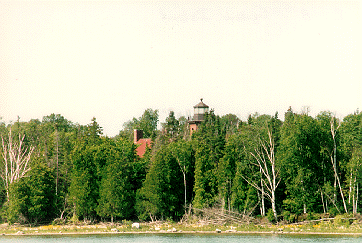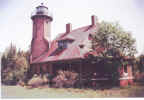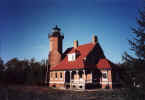 "Captain Owen J. McCauley, now 79 (in 1948), who
retired in 1936 after 38 years in the lighthouse service, tell the story of the tragedy
which took place on December 14-15, 1900. Of which he was the only survivor.
The Squaw Island light on the northernmost island in the Beaver group was closed the
morning of December 14. At 12:30 the keeper, William H. Shields, his wife, her
niece, Mrs. Lucy Davis, of Richmond, Indiana, first assistant keeper, McCauley and second
assistant keeper, Lucien Morden of Montague, along with Shield's shepherd dog, Fids,
launched the 22 foot sailboat which was to take them on the first lap of their journey
home for the winter months.
"Captain Owen J. McCauley, now 79 (in 1948), who
retired in 1936 after 38 years in the lighthouse service, tell the story of the tragedy
which took place on December 14-15, 1900. Of which he was the only survivor.
The Squaw Island light on the northernmost island in the Beaver group was closed the
morning of December 14. At 12:30 the keeper, William H. Shields, his wife, her
niece, Mrs. Lucy Davis, of Richmond, Indiana, first assistant keeper, McCauley and second
assistant keeper, Lucien Morden of Montague, along with Shield's shepherd dog, Fids,
launched the 22 foot sailboat which was to take them on the first lap of their journey
home for the winter months.
The day was cold and dense vapor hung over the water making visibility poor. A moderate wind was blowing from the northeast which gave the craft a beam wind and from the speed the party estimated they would be at St. James harbor in two hours. In less than ten minutes, however the boat was becalmed for a short time before another breeze blew up from the east forcing them to haul the sails in close to hold their course. Just as quickly the wind died down and the boat was again rocking in the swells.
In gazing about, McCauley recalls, he noticed a puff of wind coming from the north with great force and cautioned Shields who was at the helm and Morden who was where he could handle the fore sheet to be on the lookout. Instantly the squall hit the canvass and as the boat had no head-way it was laid over by the force of the wind. The boat was over balanced and slowly laid over until the sails were flat on the water. The women screamed and were helpless. When McCauley saw the boat tipping, he jumped on the side of it to avoid going in the water but when the others went in the icy water, he went to their aid. They pulled Mrs. Shields up on the upturned boat and tied her to the centerboard. Morden tied Mrs. Davis with the fore sheet and when McCauley saw that that would not hold he went down in the water and cut apart one of the sail halyards. After that the articles were thrown and shoved from the capsized boat to give it buoyancy.
Shortly after the accident they sighted a fish tug coming around the northeast point of Beaver Island but they were too far away to be seen by the fishermen although the squall had cleared the air. They had hopes however, that they would drift into the path of the tugs as the latter returned from the fishing grounds in the evening. About this time the dog, Fids, became exhausted and sank, the first victim. As darkness hovered over them they saw the lights of the returning tugs but they were too far away to make themselves heard by the men aboard the boats chugging along to their home ports.
Mrs. Davis, realizing that all was hopeless, wept bitterly and then seemed to sleep. She died about 6:30 p.m. Mrs. Shields kept asking for her niece and was told she was sleeping. She later became delirious and died about 8 p.m. McCauley, in relating the story said, 'It is beyond my ability to describe the horrible agonies suffered by the women before they died.' Morden then remarked that he would be the next victim. 'I tried to encourage him,' McCauley related, ' and told him that we were drifting toward High Island where the Indians would help us. But his hands were even numb and puffed by the cold. He was sitting erect, holding the jib sheet when suddenly he shuddered, losing his grip on the rope and slid into the water. I caught his arm and tried to help him but he pulled away. I heard splashing for a few seconds and then he sank.'
As dawn appeared and objects became visible McCauley and Shields found their boat still far from land. The Beaver Island fish tugs again appeared but they passed the northwest point of the island, and closest point was three miles from the overturned boat. As they continued to drift the two survivors knew they would miss Trout Island also. Their only hope was to drift into the steamer channel. Cold and hunger were already preying on them and a southeast wind which had started at sunrise had brought occasional snow squalls making conditions even worse.
The body of Mrs. Shields lay in the water under the gaze of her distracted husband. Shields moved about on the boat and retied himself and McCauley did the same, allowing a little slack so he could move about in an effort to keep from freezing. About the middle of the morning McCauley saw smoke to the east and after another snow squall a steamship was in sight. Shields could not even look up but McCauley managed to stand up and wave. He was sighted, the steamer swung towards them, lowered a small boat and they were carefully taken aboard. The ship was the Manhattan of the Gilchrist Steamship Company bound for Manitowoc with a cargo of coal. After the ice covered bodies of the two women were removed the ship continued to Manitowoc.
The next morning at Manitowoc the two men were taken to Holy Family Hospital. Shield's hands and feet were badly frozen but McCauley was in better condition. He was discharged from the hospital and arrived home at Beaver Island December 26th. Shields remained at the hospital for six months and one of his legs had to be removed at the knee. Following his dismissal from the hospital, Shields was appointed Keeper at the newly constructed lighthouse depot at Charlevoix where he served until his retirement in April 1924. He died in September 1925.
Captain McCauley, a native of Beaver Island, who had joined the lighthouse service in 1898, was promoted to principal keeper of the Squaw Island Light after the tragedy and remained in command until the light was closed in 1928. He was then transferred to the St. Joseph Light, where he was stationed until he retired in 1936.
What is the island and lighthouse like 99 years after the tragedy? Due to time and vandalism, the island north of Beaver is now over-grown with weeds and poison-ivy. Vandals have broken windows and removed many items that were contained within the buildings.
The above photo was taken in 1993 with the permission of the photographer, Bernard Hellstrom.
The same scene taken in 2000 with the permission of the photographer, Bernard Hellstrom.
The beautiful red brick octagonal tower for the lighthouse still remains, overlooking Lake Michigan with an unseeing eye. Attached to the tower, the keeper's dwelling is also made of red brick in a Victorian style. Even with missing windows and broken steps, it still manages to evoke images of days gone by. In the 1960's, the tiny chapel next to the house still contained a beautiful altar, belfry, stained glass windows and room for a single pew. Today, it is just an empty shell with memories of those who came seeking peace and solace and it is for sale. Mr. Bernard Hellstrom, with the permission, is working hard to restore Squaw Island Lighthouse to its former beauty.
The ends the Squaw Island section of the tour

